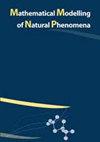红细胞在剪切流动中飞盘运动的理论研究
IF 2.1
4区 数学
Q2 MATHEMATICAL & COMPUTATIONAL BIOLOGY
引用次数: 4
摘要
剪切流中单个红细胞的动力学是一个流体-结构相互作用问题,它产生了丰富的行为,作为问题参数的函数。在低剪切率下,红细胞的变形保持较小,并且已经开发了低阶模型,预测细胞的取向和膜循环随时间的变化。它们再现了在实验和模拟中观察到的动力学,但它们没有足够简化问题,无法对现象进行简单的解释。在探索低剪切率下红细胞动力学的过程中,使用四元数重写了由5个非线性常微分方程组成的现有模型,以参数化红细胞的旋转。然后使用代数几何的技术来确定问题的稳态解。这些解决方案与红细胞达到恒定倾角的特定状态有关,红细胞膜围绕红细胞旋转,称为飞盘运动。将模型的数值解与稳态解进行比较,可以更好地理解红细胞最具象征性的运动、翻转和坦克踩踏之间的过渡。本文章由计算机程序翻译,如有差异,请以英文原文为准。
A theoretical investigation of the frisbee motion of red blood cells in shear flow
The dynamics of a single red blood cell in shear flow is a fluid–structure interaction problem that yields a tremendous richness of behaviors, as a function of the parameters of the problem. A low shear rates, the deformations of the red blood cell remain small and low-order models have been developed, predicting the orientation of the cell and the membrane circulation along time. They reproduce the dynamics observed in experiments and in simulations, but they do not simplify the problem enough to enable simple interpretations of the phenomena. In a process of exploring the red blood cell dynamics at low shear rates, an existing model constituted of 5 nonlinear ordinary differential equations is rewritten using quaternions to parametrize the rotations of the red blood cell. Techniques from algebraic geometry are then used to determine the steady-state solutions of the problems. These solutions are relevant to a particular regime where the red blood cell reaches a constant inclination angle, with its membrane rotating around it, and referred to as frisbee motion. Comparing the numerical solutions of the model to the steady-state solutions allows a better understanding of the transition between the most emblematic motions of red blood cells, flipping and tank-treading.
求助全文
通过发布文献求助,成功后即可免费获取论文全文。
去求助
来源期刊

Mathematical Modelling of Natural Phenomena
MATHEMATICAL & COMPUTATIONAL BIOLOGY-MATHEMATICS, INTERDISCIPLINARY APPLICATIONS
CiteScore
5.20
自引率
0.00%
发文量
46
审稿时长
6-12 weeks
期刊介绍:
The Mathematical Modelling of Natural Phenomena (MMNP) is an international research journal, which publishes top-level original and review papers, short communications and proceedings on mathematical modelling in biology, medicine, chemistry, physics, and other areas. The scope of the journal is devoted to mathematical modelling with sufficiently advanced model, and the works studying mainly the existence and stability of stationary points of ODE systems are not considered. The scope of the journal also includes applied mathematics and mathematical analysis in the context of its applications to the real world problems. The journal is essentially functioning on the basis of topical issues representing active areas of research. Each topical issue has its own editorial board. The authors are invited to submit papers to the announced issues or to suggest new issues.
Journal publishes research articles and reviews within the whole field of mathematical modelling, and it will continue to provide information on the latest trends and developments in this ever-expanding subject.
 求助内容:
求助内容: 应助结果提醒方式:
应助结果提醒方式:


